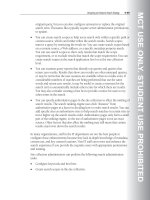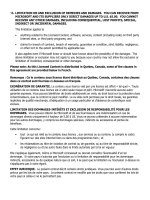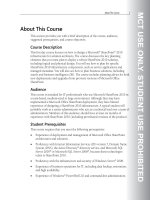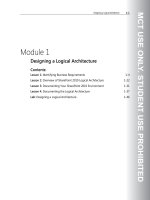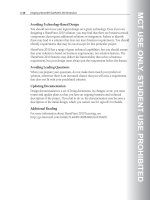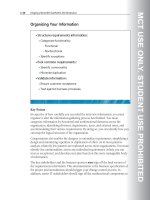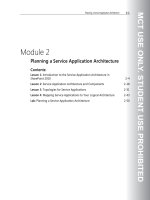Designing a Microsoft SharePoint 2010 Infrastructure Vol 1 part 25 potx
Bạn đang xem bản rút gọn của tài liệu. Xem và tải ngay bản đầy đủ của tài liệu tại đây (1.09 MB, 10 trang )
MCT USE ONLY. STUDENT USE PROHIBITED
Designing a Physical Architecture 4-37
Lesson 4
Mapping a Logical Architecture Design to a
Physical Architecture Design
There is a strong link between the logical architecture of SharePoint 2010 and the
physical architecture of SharePoint 2010. Some of the design choices that you
make for the logical architecture will have a direct impact on the physical
architecture, such as the number of databases that you require or the number of
servers that you need in the farm. This lesson maps some of the links between
logical and physical architectures, and discusses supporting requirements for your
farm topology.
Objectives
After completing this lesson, you will be able to:
• Identify existing management requirements, and the impact on SharePoint.
• Identify links between logical and physical architectures in SharePoint.
MCT USE ONLY. STUDENT USE PROHIBITED
4-38 Designing a Microsoft® SharePoint® 2010 Infrastructure
• Describe additional SharePoint topology requirements.
• Document the physical design.
MCT USE ONLY. STUDENT USE PROHIBITED
Designing a Physical Architecture 4-39
Physical Design in a Business Context
Key Points
Typically, your SharePoint farm solution will not exist in isolation. There will
usually be an existing network infrastructure with additional network services in
place, which your SharePoint farm will supplement. This means that there will be
existing elements that you must account for in your design. The following list
contains some examples of existing support requirements or policies:
• There may be existing security requirements or policies that govern how
servers can transmit data, or there may be configuration requirements for
Web servers in perimeter networks.
• There may be existing authentication requirements that the SharePoint
solution must also meet, such as two-factor authentication devices.
• There may be firewall policies that can restrict placement of domain
controllers in the perimeter network or prevent logon traffic from successfully
passing.
MCT USE ONLY. STUDENT USE PROHIBITED
4-40 Designing a Microsoft® SharePoint® 2010 Infrastructure
• When you calculate network usage and bandwidth requirements, you must
take account of other network usage on shared network segments. You must
include this usage in your calculations and your performance testing.
• Your organization may require that SQL Server DBAs administer the
SharePoint database servers instead of SharePoint administrators.
MCT USE ONLY. STUDENT USE PROHIBITED
Designing a Physical Architecture 4-41
Mapping Logical Architecture Design to Physical
Specifications
Key Points
After you have established a logical architecture design, you can decide on the
physical farm, server specifications, and number of servers. Many of the logical
architecture elements will have an impact on the physical specifications. The
following table lists some examples of relationships between logical design and
physical requirements.
MCT USE ONLY. STUDENT USE PROHIBITED
4-42 Designing a Microsoft® SharePoint® 2010 Infrastructure
Logical design requirements Impact on physical specifications
Size of repository For large content collections (corpus over 40 million
items) or multiple-farm scenarios, this repository may
require a dedicated search farm.
Number of Web applications The number of Web applications, and the number of
users who connect to them, will have an impact on the
number of WFE servers that you require. More WFE
servers can offer dedicated hosting of individual Web
applications.
Quantity of content As content demand increases, you require additional
databases to store content beyond 200 GB. Further
demand may result in splitting service application
databases, such as search, onto additional servers. You
may also need to review the disk storage type (RAID
configuration or SAS/SATA)
Presence of Microsoft Office
Web Apps
Microsoft Office Web Apps place more demand on
network bandwidth, in addition to WFE and
application servers.
Mappings for host headers
and alternate access
Host header and alternate access mapping use
requires additional DNS record configuration. You may
need to change internal DNS or Internet DNS or both.
Management of digital assets Digital asset management requires additional content
storage considerations, either for database storage or
for remote BLOB storage (RBS). RBS requires
compatible storage options.
In addition, you should consider configuration of BLOB
caching on WFE servers.
MCT USE ONLY. STUDENT USE PROHIBITED
Designing a Physical Architecture 4-43
Additional Topology Considerations
Key Points
In addition to designing the number of farms that you require and sizing the
farm(s), you must consider farm placement.
Network
If users who will access the farm are solely on the internal network, you can place
the farm in the internal network, and access requirements are satisfied.
If the farm must be accessible from the Internet—to corporate users, business
partners in an extranet scenario, or publicly—there are a number of options for
deployment of the farm and Active Directory. The following table describes the
server placement options and corresponding considerations.
MCT USE ONLY. STUDENT USE PROHIBITED
4-44 Designing a Microsoft® SharePoint® 2010 Infrastructure
Farm placement
Active Directory
placement
Considerations
Internal network Internal network HTTP (or HTTPS) traffic must pass from
the Internet to the WFE servers in the
internal network. For improved security,
use an application-layer firewall, such as
Microsoft Threat Management Gateway.
Perimeter network Internal network Authentication traffic must pass back from
the WFE servers to the domain controllers
in the internal network.
Split – WFE and
application servers in
the perimeter network,
computers running SQL
Server in the internal
network
Split – domain
controllers for
internal domain
in both internal
and perimeter
network
Requires careful configuration of firewall
to securely pass both Active Directory
traffic between domain controllers and
traffic from WFE and application servers
back to computers running SQL Server.
Perimeter network Perimeter
network
(separate forest)
This configuration provides Active
Directory in the perimeter network, but as
a separate forest. Typically, this prevents
single sign-on (SSO) for corporate users,
because a separate account is required for
authentication in the perimeter forest
(although you can establish a trust
relationship).
Note: You should choose an Active Directory and farm placement configuration that
best meets your organization’s security and authentication requirements.
Antivirus
You must also consider how to protect SharePoint content against viruses and
malware. You should consider integration with your corporate antivirus strategy,
or you may require dedicated SharePoint antivirus software if your current
antivirus software does not provide integration with SharePoint 2010.
High Availability
You must also consider high-availability requirements—additional servers may be
necessary to support extended uptime requirements. For high-availability
requirements, you must consider the three farm tiers separately:
MCT USE ONLY. STUDENT USE PROHIBITED
Designing a Physical Architecture 4-45
• To implement high availability for WFE servers, you require at least two WFE
servers that host the same Web application, with load balancing. The load
balancing element may be a hardware load balancer or the network load
balancing (NLB) feature in Windows Server 2008. NLB is available in
Windows Server 2008 Web, Standard, Enterprise, and Datacenter editions.
• To implement high availability for service applications, you can implement
multiple application servers that host the same services.
• To implement high availability for databases, you require at least two
computers running SQL Server. You can configure these for database
mirroring (which requires duplicate storage), or you can configure them as
part of a SQL Server failover cluster (which requires shared storage).
Note: You may also be able to achieve high availability when you virtualize SharePoint
servers. Depending on the virtualization platform requirements, a single virtual WFE,
application, or database server can be highly available across multiple virtual host servers.
Question: You decide to implement two computers running SQL Server in a
mirrored configuration for high availability. Will this configuration also improve
performance? Explain your reasons for your answer.
Additional Reading
For more information about how to plan for availability in SharePoint 2010, see
MCT USE ONLY. STUDENT USE PROHIBITED
4-46 Designing a Microsoft® SharePoint® 2010 Infrastructure
Documenting the Physical Design
Key Points
After you have designed your physical server requirements and farm topology, it is
important to document your design and record all of the required elements ready
for deployment. This design document will also help when you deploy the farm,
because you can identify dependencies, create a work sequence to follow, and
ensure that you do not forget any requirements during deployment.
You should create a worksheet to describe the server requirements, including the
server hardware configuration, network settings, domain membership, and which
servers will host service applications in the farm.
After you create the server planning worksheet, you can create a network diagram
of your farm topology. This diagram can detail:
• The number and type of servers.
• Additional requirements, such as domain controllers or firewalls.
• The type of storage that servers will use, such as DAS or SAN.
